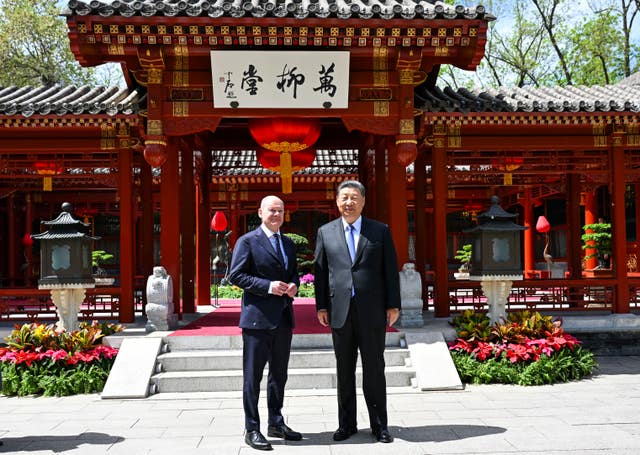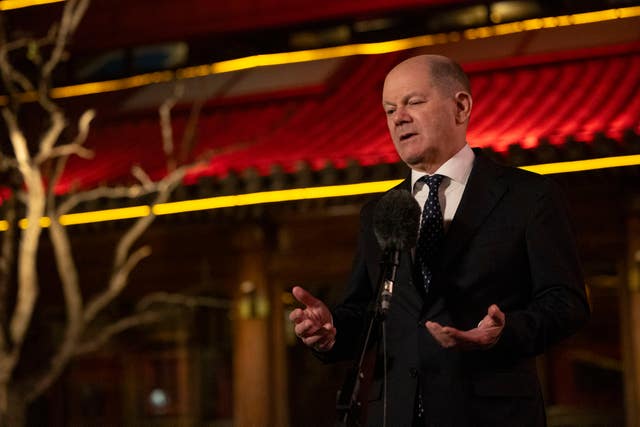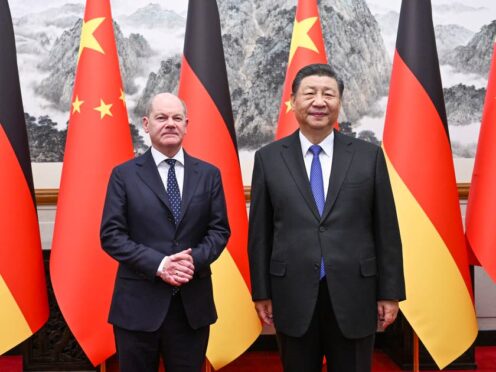German Chancellor Olaf Scholz said he asked Chinese leader Xi Jinping to pressure Russia to end its “insane campaign” in Ukraine, the latest in a parade of European leaders and senior officials to make such an appeal.
The Chinese side gave no sign of any change in its position, which has been to blame Europe and the US for prolonging the fighting by supplying Ukraine with weapons and calling for peace negotiations that recognise Russian as well as Ukrainian concerns.
“China is not a party to the Ukraine crisis but has consistently promoted talks for peace in its own way,” read a Chinese statement following talks between Mr Xi and Mr Scholz in the Chinese capital Beijing.

Mr Scholz, winding up a three-day visit to China, told journalists that he believes “a building block has been put in place” that will contribute to discussions on diplomatic efforts to end the war.
Earlier, he said in a post on the social media platform X that he had asked Mr Xi to use his influence with Russia.
“China’s word carries weight in Russia. So I asked President Xi to bear upon Russia so that Putin finally breaks off his insane campaign, withdraws his troops and ends this terrible war,” he wrote.
China has broken with the West in refusing to criticise Russia’s invasion.
While the government says it is not sending military aid to Moscow, it has provided an economic lifeline by growing trade with Russia, helping it cope with Western sanctions.
A US intelligence report last week found Beijing has increased equipment sales to Moscow to indirectly boost its war effort against Ukraine.
Mr Scholz said the talks had addressed China’s exports of so-called dual-use goods, which can have both civilian and military purposes.
“There is an absolute insistence that there be no weapons exports, but the question of dual-use also must not be ignored,” he said.

“And it was possible to bring up everything that is necessary here in a way that it can’t be misunderstood.”
Mr Scholz also said the use of nuclear weapons should not even be threatened, according to a German government transcript of his remarks at the start of the meeting with Mr Xi.
Russian President Vladimir Putin warned last month that his government is ready to use nuclear weapons if its sovereignty or independence is threatened, his latest such threat since invading Ukraine.
A Chinese statement said the two leaders noted that China and Germany stand committed to the UN Charter and oppose the use of nuclear weapons.
“China encourages and supports all efforts that are conducive to the peaceful resolution of the crisis, and supports the holding in due course of an international peace conference that is recognised by both Russia and Ukraine and ensures the equal participation of all parties and fair discussions on all peace plans,” the Chinese statement said.
On trade, Mr Xi told Mr Scholz that their two countries should stay vigilant against the rise of protectionism and take an objective view of the issue of manufacturing capacity, according to the statement.
The German leader’s visit has underscored trade-related tensions as the European Union and the United States complain that China is competing unfairly through the use of subsidies that have created massive production capacity, particularly for solar panels, electric cars and other green-energy products.
The EU is mulling tariffs to protect its producers against cheaper Chinese electrical vehicle imports, which some fear will flood the European market.

Mr Scholz, meeting separately with Chinese Premier Li Qiang, called for concrete improvements in several areas for German companies operating in China, including market access, fair competition, intellectual property protection and the legal system.
“In order for these companies to be able to continue doing so, they need the right conditions,” he said.
Despite the political and trade frictions, China was Germany’s top trading partner for the eighth straight year in 2023, with 254.1 billion euros (£217 billion) in goods and services exchanged between the sides, slightly more than what Germany traded with the US but a 15.5% contraction from the year before.
This is Mr Scholz’s second trip to China since he became chancellor in late 2021.
It is his first visit since the German government last year presented its China strategy, which met with criticism from Beijing.
Mr Li, the Chinese premier, visited Berlin in June.
